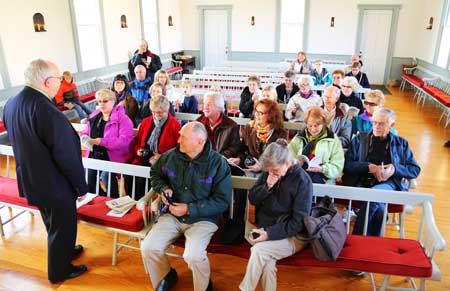
An icy wind greeted us this morning. 34 degrees Fahrenheit feels like winter! However, after the many hours of traveling on our bus yesterday, it was a great relief to spend very little time riding our trusted vehicle. In fact, we only had to go to one location: the Adventist Historic Village, located on the west end of Battle Creek, Michigan.
The Village covers three blocks and contains “authentically restored or replicated buildings” that feature “the heritage of the Seventh-day Adventist Church”—that’s what it says on the ministry’s website (www.adventistheritage.org). I must say I enjoyed the hours spent in the homes of Ellen and James White, Deacon John White, the Parkville Church, the Second Meeting House, a nineteenth-century schoolroom, an authentic log cabin, and—last not least—the William J. Hardy exhibit, focusing on the story of African-American Adventist pioneers.![SINGING WITH THE ANGELS: Under the directorship of Jim Nix, our impromptu choir sings Ellen White’s favorite hymn--“Jesus, Lover of My Soul.” [PHOTO: GK]](https://adventistreview.org/wp-content/uploads/2022/01/13-10-23-1.jpg)
I especially enjoyed the story of Anna Knight, educator, nurse, social reformer, literature evangelist, and the first African-American missionary to India. She must have been quite the lady: when threatened by white moonshiners in her native Mississippi, she strapped a Colt revolver to her side, ready to face her persecutors. People knew that she meant business, and she continued to teach the ABCs and warned those willing to listen about the evils of alcohol.
Anna Knight is a good example of early Adventist educators: they were passionate, willing to innovate, ready to improvise, and wanted to see their students reach their potential. They didn’t always enjoy clear sailing—matter of fact, they didn’t always agree with one another, as the conflict regarding the location of Battle Creek College showed. When educators heeded the guidance of Ellen White, Adventist education flourished. When they chose to go a different route, things got complicated.
I need to confess: I too feel passionate about Adventist education. Prior to arriving at the offices of the Adventist Review in 2009, I spent more than 15 years in classrooms, educating future pastors. I enjoy working with young minds, and love the energy of undergraduate students who are ready to change the world. (Remember, our early pioneers such as James and Ellen White, J. N. Andrews, John Loughborough, and many others were the ages of undergraduate students in our current universities and colleges). I like the mental fencing that marks postgraduate classes. I relish the immediate feedback of classroom teaching. A good teacher doesn’t have to wait until the exam to know when a student gets or it when he or she has just “checked out.” So, Adventist education is near and dear to my heart.
When I saw the humble beginnings of our educational system I couldn’t help but marvel at God’s blessings. Today and every day, nearly 1.7 million students are mentored by 85,000 teachers. Close to 8,000 schools, colleges, and universities open their doors to communicate a biblical worldview to their students. Some of them are state-of-the-art classrooms and buildings with superb research facilities. Others have dirt floors and no windows. Yet all of them find their origin in the early Adventist attempts to teach the entire person (we usually use the adjective “wholistic” to describe this approach), recognizing that education is redemption.
And it all began with young people, like Anna Knight, who didn’t accept the status quo and were ready to step out in faith; who saw learning as a process and not as an accomplishment; and who were committed to mentor their students into the Kingdom. I’d like to commit to this lofty goal again—in the classroom and in the pages of the Adventist Review.